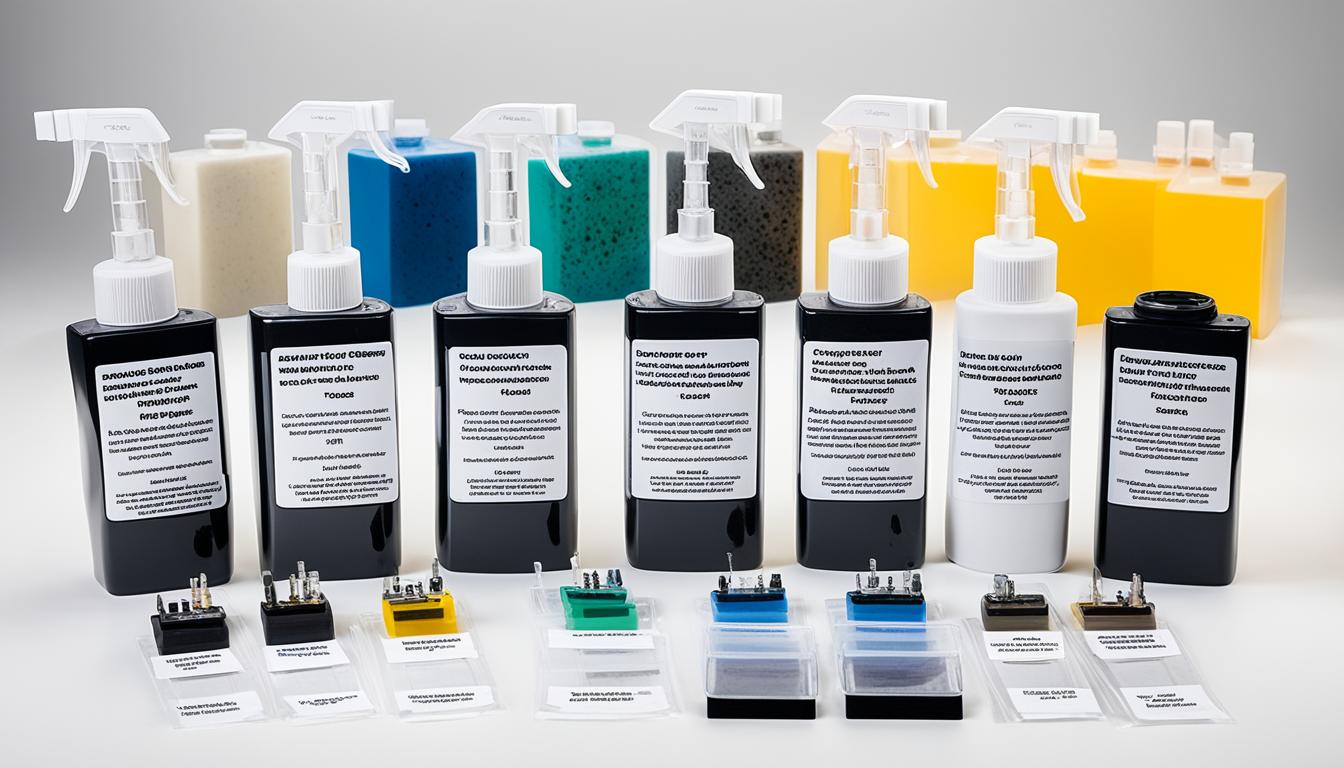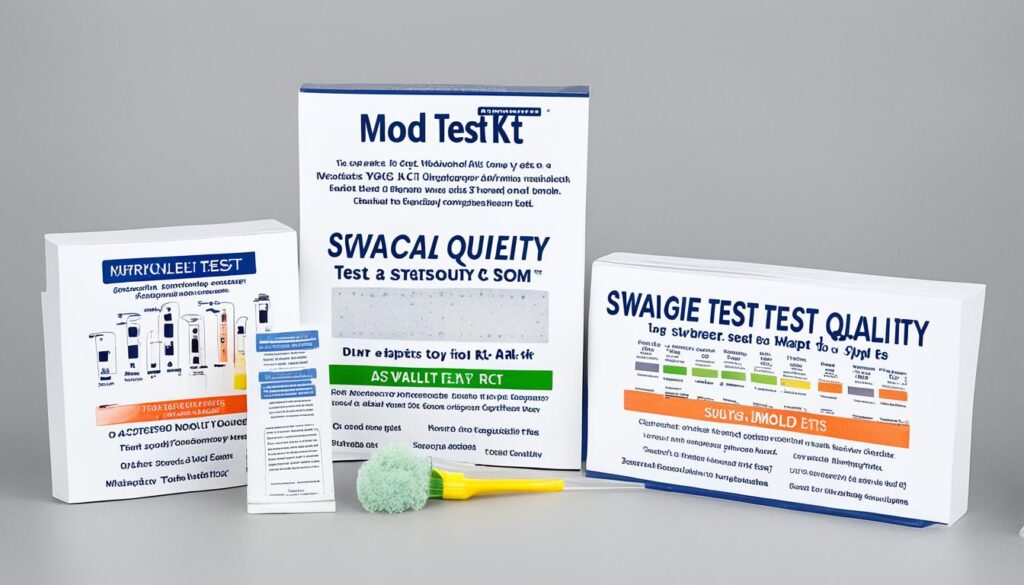
Different Types of Black Mold Tests Available
Identifying and assessing the presence of black mold in your home or indoor environment is crucial for maintaining a safe and healthy living space. Fortunately, there are several types of mold tests available that can help you in this process. In this section, we will explore the different types of black mold tests, including their advantages and limitations.
Key Takeaways:
- Various types of black mold tests are available to identify and assess mold presence.
- Diy mold test kits are an affordable option for homeowners, but their accuracy may vary.
- Professional mold testing provides a more comprehensive assessment of mold presence and severity.
- Other mold testing methods include air sampling, surface sampling, bulk sampling, and indoor air quality testing.
- Choose a mold testing method that best suits your needs and budget while prioritizing the health and safety of your indoor environment.
DIY Mold Test Kits
If you suspect the presence of black mold in your home, DIY mold test kits offer an affordable and convenient solution for testing on your own. These kits are designed for homeowners who want to take control of their indoor environment and ensure the safety of their living spaces.
DYI mold test kits typically include test swabs or strips that can be easily used to collect samples from areas suspected of mold growth. By following the instructions provided in the kit, you can collect the samples confidently and efficiently.
Once the sample is collected, it needs to be sent to a laboratory for detailed analysis. The laboratory analysis is crucial in determining the presence and concentration of black mold spores in the collected sample.
Please note that while DIY mold test kits can provide preliminary information about the presence of black mold, their accuracy may vary. It’s essential to carefully follow the instructions, collect the samples from multiple areas of concern, and ensure that the samples are properly handled and shipped.
Benefits of DIY Mold Test Kits:
- Cost-effective solution for homeowners
- Convenient and easy to use
- Offers privacy and control over the testing process
- Provides preliminary information about mold presence
However, it’s important to remember that DIY mold test kits may not provide a comprehensive assessment of the mold issue. For a more in-depth evaluation and accurate results, professional mold testing may be necessary.

When choosing a DIY mold test kit, look for reputable brands and ensure that the kit includes clear instructions and prepaid shipping labels for sending the samples to the laboratory. By following the instructions carefully and seeking professional help if needed, you can take the necessary steps to address any mold concerns in your home.
Professional Mold Testing
When it comes to assessing mold growth in your property, professional mold testing offers a comprehensive solution. By hiring a certified mold inspector, you can ensure a thorough examination of your indoor environment and accurate identification of black mold.
Professional mold inspectors utilize specialized equipment, such as air sampling devices and moisture meters, to detect and identify mold presence. These devices enable them to collect samples from the air and surfaces, allowing for a more precise analysis.
In addition to using advanced equipment, mold inspectors also conduct a visual inspection of your property. This visual assessment helps identify any visible signs of mold growth and areas of concern that require further attention.
By opting for professional mold testing, you can benefit from:
- Accurate mold detection: Certified inspectors are trained to identify different types of mold, including black mold, allowing for an accurate assessment of mold presence in your home.
- Thorough analysis: Professional mold testing provides a comprehensive evaluation of mold growth, including its severity and potential impact on your indoor environment.
- Qualified expertise: Mold inspectors possess the knowledge and experience necessary to interpret test results accurately, helping you understand the extent of your mold problem.
When to Consider Professional Mold Testing?
If you notice visible signs of mold growth, experience persistent musty odors, or suspect mold-related health issues, it’s crucial to consider professional mold testing. Professional mold inspectors can assist in identifying hidden mold growth and provide recommendations for remediation.

| Benefits of Professional Mold Testing | DIY Mold Testing |
|---|---|
| Comprehensive assessment of mold presence | Basic indication of mold presence |
| Identification of hidden mold growth | Limited ability to detect hidden mold |
| Accurate analysis with specialized equipment | Preliminary analysis with test kits |
| Expert interpretation of results | Limited knowledge of mold analysis |
Other Mold Testing Methods
In addition to DIY kits and professional inspections, there are other mold testing methods that can help you assess and address black mold issues in your indoor environment.
Air Sampling
Air sampling is a mold testing method that measures the concentration of mold spores in the air. This method involves collecting air samples from different areas of your home using specialized equipment, such as air pumps and spore traps. The samples are then analyzed in a laboratory to determine the types and quantities of mold spores present. Air sampling can provide valuable information about the overall mold contamination level in your indoor environment.
Surface Sampling
Surface sampling involves collecting samples from visible mold growth on surfaces such as walls, ceilings, or floors. These samples are often collected using adhesive tape or swabs and are then examined under a microscope or sent to a laboratory for analysis. Surface sampling can help identify the specific type of mold present and determine its concentration on different surfaces.
Bulk Sampling
Bulk sampling is a mold testing method that involves collecting physical samples of materials suspected to have mold growth. These samples can include pieces of drywall, carpet, or insulation. The collected samples are then analyzed to identify the presence and concentration of mold. Bulk sampling is particularly useful when the mold growth is not visible, but there are signs of moisture or musty odors.
Dust Sampling
Dust sampling is a method that involves collecting settled dust from various surfaces within your home. This dust is then analyzed to determine the presence of mold spores and other contaminants. Dust sampling can provide insights into long-term mold exposure and help identify potential mold sources.
Indoor Air Quality Testing
Indoor air quality testing is a comprehensive approach to assess overall air quality and identify potential mold issues. This testing method involves analyzing samples collected from the air, surfaces, and other sources to evaluate the presence of mold spores, volatile organic compounds (VOCs), and other pollutants. Indoor air quality testing can help ensure a healthy and safe indoor environment for you and your family.
By utilizing these mold testing methods, you can effectively identify and address mold issues in your home, ensuring a healthier indoor environment for you and your loved ones.
Conclusion
After exploring the different types of black mold tests available, it is crucial to select the method that best fits your needs and budget. DIY mold test kits can provide a preliminary indication of mold presence, making them a convenient and cost-effective option for homeowners. However, their accuracy may vary, so it’s essential to interpret the results with caution.
For a more comprehensive assessment of mold presence, professional mold testing is recommended. Certified mold inspectors utilize specialized equipment and techniques to detect and identify black mold. This approach offers a thorough evaluation of your property’s mold situation, allowing for a more informed decision on mitigation and remediation measures.
In some cases, additional testing methods such as air sampling or surface sampling may be necessary to fully assess the extent of mold contamination. These methods provide valuable insights into airborne spore levels and visible mold growth, respectively. Furthermore, conducting indoor air quality testing can help identify potential mold issues and ensure a healthier indoor environment for you and your family.
Remember, the health and safety of your indoor environment should be a top priority. If you encounter persistent mold issues or suspect a severe contamination, seeking professional assistance is highly recommended. Mold experts have the expertise and experience to address mold-related concerns effectively, ensuring a thorough assessment and appropriate remediation strategies.




